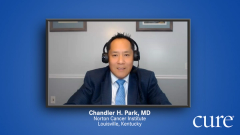
Advanced RCC: Safety and Efficacy of IO/TKI Combination Therapies
Genitourinary oncologists discuss the safety and efficacy of IO/TKI and IO/IO combination therapies in advanced renal cell carcinoma.
Episodes in this series

Transcript:
Tian Zhang, M.D., M.H.S.: In terms of front-line therapies, as we just mentioned, there are multiple immunotherapy [IO] combinations. When we look at ipilimumab-nivolumab, this is the pure immunotherapy accommodation from an efficacy standpoint; it does prolong overall survival [OS] when compared with sunitinib in the metastatic setting.
Our longest follow-up data for this combination comes from CheckMate 214 [NCT02231749], which was a phase 3 trial with a five-year follow-up now showing improved survival outcomes. The VEGF [anti-vascular endothelial growth factor] IO combinations also have shown improvements in OS and of note improvements in early progression-free survival [PFS] compared with sunitinib. We recently had data from ASCO [the American Society of Clinical Oncology Annual Meeting] 2023 from KEYNOTE-426 [NCT02853331], which was the axitinib with pembrolizumab combination, showing improved OS as well as improved PFS.
Then in the CLEAR trial [NCT02811861], from lenvatinib with pembrolizumab, we also saw both improved OS as well as improved PFS compared with sunitinib. And then finally, the cabozantinib and nivolumab combination also has shown both OS and PFS compared with sunitinib. When we talk about side effects, we absolutely have to think about the toxicities of these treatments when we’re deciding on the right combination to use.
And when we talk about these treatments, I often tell our patients that immunotherapy activates the immune system wherever [it is] active in the patient’s body. So on the skin, it can cause a rash; in the GI [gastrointestinal] tract, it can cause colitis or diarrhea; and then rarely would it cause inflammation of the liver, lungs, or kidney themselves. And finally, endocrinology, so toxicities affect the endocrine organs. The most common of [these] is thyroiditis or the toxicity of the thyroid, either high levels or low levels of thyroid hormone, and then also toxicities involving the pituitary-adrenal glands and pancreas.
We watch all of those hormone factors very carefully during the course of treatment. Now, when we add in the anti–blood vessel blockade, and our anti-VEGF therapies, these treatments often affect the cardiovascular system in particular. About 50% of patients will develop some elevated blood pressure, hypertension over baseline, and then also hand-foot syndrome or a painful rash on the palms of the hands in the soles of the feet. Mouth ulcers or taste changes are also pretty particular for the anti-VEGF component of these combinations. There are some overlapping toxicities, such as the diarrhea and the elevated liver function that we also keep an eye on and try to tease apart whether they’re due to the anti-VEGF blockade or if they’re due to the immunotherapy.
Chandler H. Park, M.D.: There are four landmark studies that I’m going to go into with detail. One was called the CLEAR study. The CLEAR study was a Phase 3 randomized study where patients [had] advanced renal cell and Stage 4 kidney cancer, and the medications were lenvatinib, which is a TKI [tyrosine kinase inhibitor] we talked about. And the dance partner was known as pembrolizumab, which is immunotherapy. The patients were randomized to either that treatment or the comparison arm, [which was] was sunitinib. There was a third arm of lenvatinib and everolimus. But, for the sake of the conversation, all of the trials used sunitinib as the comparison arm, so we’re just going to talk about sunitinib vs lenvatinib and pembrolizumab.
It was very striking…as a cancer doctor, the thing I look for is, how does the cancer respond? What is the response rate? If we have 100 people, how many of those patients are going to respond to treatment? The second thing I look at is, if I start them on medication three months from now, because typically that’s when we do a scan, what is the chance that the cancer is going to shrink, i.e., respond, or is cancer going to get worse? And the last thing is, are there any spots remaining? Let’s call it a complete response. A complete response means if you have some spots on the CT scan, you undergo treatment, and then on future CT scans, there are no spots. The CT scan is how we look for cancer.
In the CLEAR study, it had the highest response rate. Close to 70 to 71 out of 100 people responded to this medication, which is phenomenal in terms of a complete response; 17 out of 100 people had a complete response, which is striking. What’s the chance of cancer three months from now after you start this treatment? Are you going to have to give bad news to the patient? That is called progressive disease. Progressive disease means that you start a treatment and later on, three months from now, when you do the CAT scan, what’s the chance that you’re going to end up giving that patient bad news? That’s called progressive disease. In the CLEAR study, progressive disease was only 5%, which means three months from now, if you do this regimen, 19 out of 20 people that are on this regimen will either have cancer remaining the same size, getting smaller, or disappearing. So that really moved the needle for me.
Now, the problem with the CLEAR study and the lenvatinib and the pembrolizumab is at what price? This is where the kidney doctors and cancer doctors like myself really have to roll up our sleeves and keep an eye on things, because even though you might get a better response, you also have more toxicity. One of the things that I look for is high blood pressure. I always talk to my patients about high blood pressure on this medication, and make sure they have blood pressure cuffs at home. [Another one] is diarrhea. We have to know about any diarrhea. We have to treat the diarrhea. And we can also do a lower dose for the diarrhea. And then thyroid conditions are something I think about. So that’s the CLEAR study. It’s got the highest CR [complete response], the highest response rates and the lowest progressive disease. But you have to think about the toxicities because the patients, if you don’t treat them in a good fashion, you could end up with a lot of side effects.
The second study is called the KEYNOTE-426. The KEYNOTE-426 also uses the backbone of TKI with an immunotherapy. The TKI they used in this study was axitinib. The medication for the immunotherapy was called pembrolizumab. In this study, in the KEYNOTE-426, the response rate was very high. It was [about] 60%. The CR was in the 11% to 12% range. Progressive disease was in the 10% to 15% [range]. But the one thing about this combination is axitinib has the shortest half-life. So for our patients, it tends to be if you have any side effects of the medication, it’s much easier to control because if you hold that medication for three days and it’s caused by the TKI pill, the side effects would go away. So it’s much easier to control, but you do lose some of that CR and so on. Now it’s hard to compare studies, so I’ll just look at the terms of each study and not really compare.
In terms of the third combination called the CheckMate-9ER [NCT03141177]. The CheckMate-9ER is also composed of two treatments, one TKI, which is cabozantinib, and the second is nivolumab, which is a checkpoint inhibitor. Now, cabozantinib is like the Swiss Army knife of all the different TKIs. It is used for a lot of different diseases. It’s got a great response. In many of the studies, cabozantinib is treated at 60 milligrams per kilogram for kidney cancer, but in this study was 40 mg and nivolumab was every two to four weeks, depending upon the dosing of 240 and 480. In terms of the CR, it was in the 11% to 12% range. So, very respectable. In terms of progressive disease, it was [about] 67%. So that’s very low. In terms of response rate, it was in the 57% to 58% range.
Now, the one thing that I look at in terms of this combination for my patients is they have some really good data. It’s called the health quality of life data, reporting how our patients do with medication, fatigue, whether it is a hand-foot condition, where your hands are red or your feet are red. So the health-related quality of life of this combination is very impressive. This is something I think about for our patients when I’m thinking about the health-related quality of life.
Transcript is AI-generated and edited for clarity and readability.






